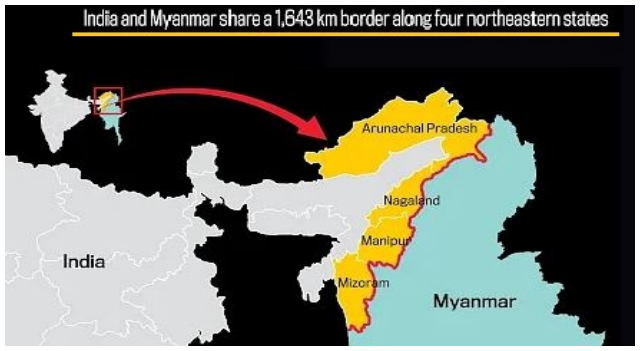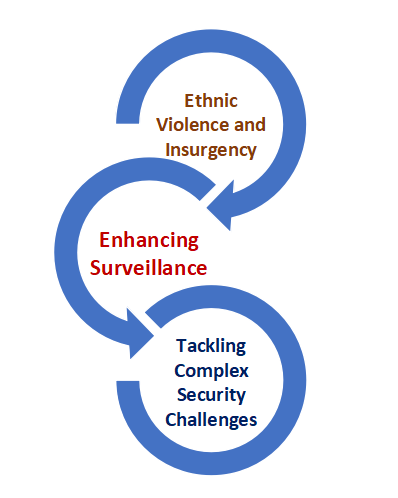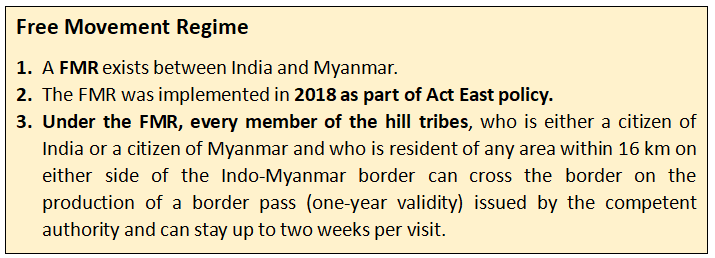- Courses
- GS Full Course 1 Year
- GS Full Course 2 Year
- GS Full Course 3 Year
- GS Full Course Till Selection
- Answer Alpha: Mains 2025 Mentorship
- MEP (Mains Enrichment Programme) Data, Facts
- Essay Target – 150+ Marks
- Online Program
- GS Recorded Course
- Polity
- Geography
- Economy
- Ancient, Medieval and Art & Culture AMAC
- Modern India, Post Independence & World History
- Environment
- Governance
- Science & Technology
- International Relations and Internal Security
- Disaster Management
- Ethics
- NCERT Current Affairs
- Indian Society and Social Issue
- NCERT- Science and Technology
- NCERT - Geography
- NCERT - Ancient History
- NCERT- World History
- NCERT Modern History
- CSAT
- 5 LAYERED ARJUNA Mentorship
- Public Administration Optional
- ABOUT US
- OUR TOPPERS
- TEST SERIES
- FREE STUDY MATERIAL
- VIDEOS
- CONTACT US
Smart Fencing System Along India-Myanmar Border
Smart Fencing System Along India-Myanmar Border
19-10-2023

Latest Context
In October, 2023 the Ministry of Home Affairs, in its 2022-23 annual report, has introduced a plan to build a 100-kilometer Smart Fencing System (SFS) along the India-Myanmar border.

Need for SFS along the India-Myanmar Border:

- Ethnic Violence and Insurgency: The presence of an unfenced border and unregulated migration from Myanmar have been attributed as some of the factors responsible for the ethnic violence in Manipur.
- The report stated that in 2022, out of the 201 insurgency-related incidents registered in all the northeast States, as many as 137 incidents were registered in Manipur.
- Smart fencing system will prevent unauthorized entry and infiltration by insurgents/militants and illegal actors, addressing a pressing security issue.
- Enhancing Surveillance: A smart fencing system equipped with advanced surveillance technologies to monitor and respond to border breaches in real time.
- Tackling Complex Security Challenges: The northeastern region faces a fragile security situation due to factors such as terrain, socio-economic development, tribal rivalries, and migration.
- The smart fencing system is a proactive measure to mitigate these threats and maintain peace and stability in the region.
Key Points Regarding the India-Myanmar Border
- India shares a long land border of over 1643 km with Myanmar as well as a maritime boundary in the Bay of Bengal.
- Four northeastern states, viz. Arunachal Pradesh (520 km), Nagaland (215km), Manipur (398 km) and Mizoram (510 km).
- Out of 1,643 km, a demarcation of 1,472 km has been completed as per the MHA’s 2022-23 annual report.
- Myanmar is the only ASEAN country adjoining India and, therefore, is a gateway to SouthEast Asia.

Other Smart Fencing Projects in India
- India’s first ‘smart fence’ pilot project was launched along the India-Pakistan border in 2018.
- Later the project BOLD-QIT (Border Electronically Dominated QRT Interception Technique) was launched under the Comprehensive Integrated Border Management System (CIBMS) on the Indo- Bangladesh border in 2019.
- Two pilot projects covering about 71 Kms on Indo-Pakistan Border (10 Kms) and Indo-Bangladesh Border (61 Kms) of CIBMS have been completed.
- CIBMS involves deployment of a range of state-of-the-art surveillance technologies — thermal imagers, infra-red and laser-based intruder alarms, aerostats for aerial surveillance, unattended ground sensors that can help detect intrusion bids, radars, sonar systems to secure riverine borders, fiber-optic sensors and a command-and-control system that shall receive data from all surveillance devices in real time.



